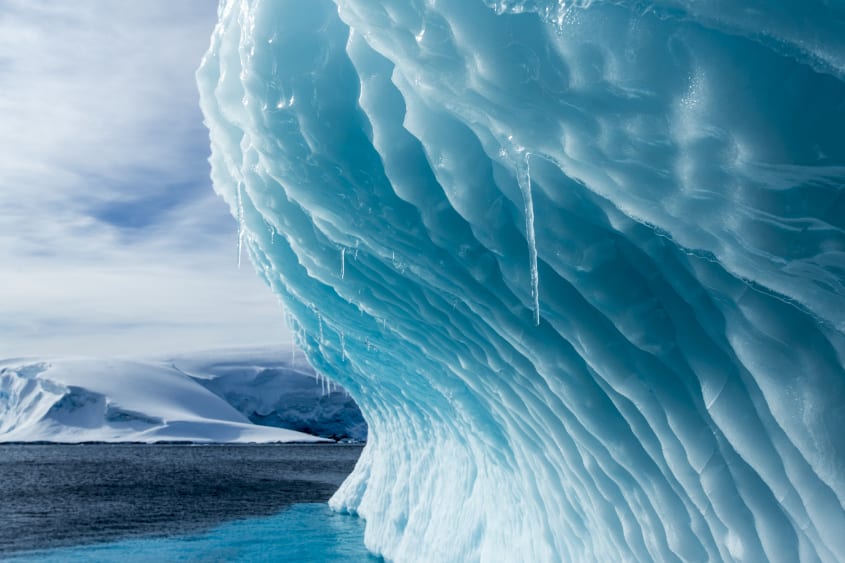Blue iceberg in Antarctica. Paul Souders/Getty Images
Scientists are on a quest to find the oldest ice on Earth, but what exactly are they hoping to find? Here’s everything you need to know:
What are scientists looking for?
Armed with drill bits, scientists have traveled to Earth’s southernmost continent – Antarctica – hoping to uncover a piece of geological history. In particular, scientists are trying to recover the oldest pieces of ice on Earth in hopes of learning how Earth’s climate has changed, writes Scientific American.
The aim is to recover an ice core that has been preserved under layers of snow for years by drilling several kilometers deep. The nuclei act almost like the rings in a tree in that they can paint a picture of Earth’s atmosphere over time. To make things even more interesting, there is a “friendly race” between Europe, Australia and the US – where the project is called the Center for Oldest Ice Exploration, or COLDEX – to see who can find and extract the ice first.
While the oldest known ice core is around 2.7 million years old, per Sciencethe oldest continually Ice core comes from only 800,000. And because the 2.7-million-year-old core comes from the edge of the continent, it’s not nearly as old in layers as the continuous core. With the introduction of COLDEX, the scientists hope to close the gaps between the two parts.
“It’s like a box of puzzle pieces. With a traditional [continuous] Ice core, all the pieces of the puzzle are in exactly the right place,” said Christo Buizert, head of the COLDEX ice analysis team. But drill cores collected from the rim of the continent “are like someone just took the jigsaw puzzle and mixed all the pieces together.”
There is evidence that even older ice can be found, some of which may be as old as 5 million years. “The ice that is deposited on the surface of Antarctica gets buried and gradually flows towards Antarctica [continent’s] Edges – and then eventually lost by melting in the ocean or calving as icebergs in the ocean. Because of this process, the oldest ice is always rare,” said Ed Brook, director of COLDEX Scientific American.
Why are scientists interested in the ice?
The ice contains air bubbles that indicate atmospheric conditions when it first froze, giving researchers valuable comparative data for measurements of today’s atmosphere. As Scientific American notes, “This is as close to time travel as scientists can get.”
“How much is sea level rising? How much is the climate warming?” Brook asked for a report climate wire. “By getting a much more accurate picture of the concentration of greenhouse gases in the atmosphere, we should be able to make more accurate statements about how sensitive the Earth system is to greenhouse gases.”
In particular, COLDEX hopes to extract a contiguous 1.5 million-year-old core, a goal shared by both the European and Australian teams. Such ancient samples would give scientists a glimpse into the climate “ahead of time.”
“There’s a reason we’re interested in these earlier [ice] Intervals,” said Sarah Shackleton, a member of the COLDEX team and a postdoctoral researcher in paleoclimatology at Princeton University. “And that’s because they were warmer.”
What can the old ice tell us about the climate?
Scientists can analyze gas concentrations in the ice’s air bubbles to paint a picture of atmospheric composition years ago, as well as identify the planet’s “climate heartbeat,” or the relationship between carbon dioxide and Earth’s temperatures. For example, atmospheric carbon dioxide in the 2.7-million-year-old sample “did not exceed 300 parts per million,” which is “significantly below today’s levels.” Science wrote in 2017.
Although the planet has long suffered from climate changes, these fluctuations used to be much smaller than they are today. To that end, the ice samples offer researchers the opportunity to compare today’s rapid human-induced climate changes with those that actually occurred Before People.
“A perfect analogy would be if someone burned all fossil fuels 2 million years ago,” Brook said per climate wire. “So the changes in the past are not as rapid as we are witnessing them now. But there is still information that is still very important to understand how the climate works.”
You may also like
Why US teenagers don’t get driver’s licenses
Nearly all of Russia’s army is in Ukraine, suffering the attrition of WW1, Britain says
Senator John Fetterman is being treated for clinical depression
Don’t miss interesting posts on Famousbio










